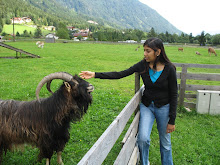 Saint Aandal (a.k.a, Nachiar, Kothai, Chudi Kodutha Chudar Kodi) was the daughter of Vishnuchitta (a.k.a Periyazhwar) who lived in Srivilliputtur, near Madurai. Vishnuchitta procured flowers for the worship of the Lord Vishnu at a temple. One morning, he discovered a baby girl lying under a tulasi plant in his garden. Having no family of his own, Vishnuchitta felt it was God's grace that gave him this child and named her Kothai. Naturally, Kothai grew up in an atmosphere of love and devotion. Vishnuchitta sang songs to her about his beloved Vishnu, taught her all the stories and philosophy he knew, and shared with her his love of Tamil poetry. Gradually the love for the Beloved Lord intensified in her. Even as a child, Kothai made up her mind to marry none but the Lord Vishnu. She adorned herself daily with the flower, and thinking of herself as Lord Vishnu's bride, she would put the garland back, for her father to take to the temple and offer to the Lord. One day, her father caught her unawares, admiring herself in the mirror with the garlands. He was scandalized and mortified beyond belief that his daughter could so defile a sacred adornment. He scolded Kothai for her misuse of the garland and discarded it. That night, the Lord Vishnu appeared to Vishnuchitta in his dream and asked him the reason for discarding the garland and said that he would be pleased to wear the garlands once worn by Kothai. He realized the intensity of Kothai’s love for the Lord and her spiritual greatness. Since then she is known as "Aandal", the girl who "ruled" over the Lord.
Saint Aandal (a.k.a, Nachiar, Kothai, Chudi Kodutha Chudar Kodi) was the daughter of Vishnuchitta (a.k.a Periyazhwar) who lived in Srivilliputtur, near Madurai. Vishnuchitta procured flowers for the worship of the Lord Vishnu at a temple. One morning, he discovered a baby girl lying under a tulasi plant in his garden. Having no family of his own, Vishnuchitta felt it was God's grace that gave him this child and named her Kothai. Naturally, Kothai grew up in an atmosphere of love and devotion. Vishnuchitta sang songs to her about his beloved Vishnu, taught her all the stories and philosophy he knew, and shared with her his love of Tamil poetry. Gradually the love for the Beloved Lord intensified in her. Even as a child, Kothai made up her mind to marry none but the Lord Vishnu. She adorned herself daily with the flower, and thinking of herself as Lord Vishnu's bride, she would put the garland back, for her father to take to the temple and offer to the Lord. One day, her father caught her unawares, admiring herself in the mirror with the garlands. He was scandalized and mortified beyond belief that his daughter could so defile a sacred adornment. He scolded Kothai for her misuse of the garland and discarded it. That night, the Lord Vishnu appeared to Vishnuchitta in his dream and asked him the reason for discarding the garland and said that he would be pleased to wear the garlands once worn by Kothai. He realized the intensity of Kothai’s love for the Lord and her spiritual greatness. Since then she is known as "Aandal", the girl who "ruled" over the Lord.Aandal blossomed into a beautiful young woman. Her desire was to become the consort of Lord Vishnu at the Srirangam temple. Vishnuchitta became desperate. Lord Vishnu again appeared in his dream and asked that Aandal be sent to Him in all her wedding finery. Vishnuchitta followed Lord Vishnu’s words. Aandal reaching Srirangam temple ran into the sanctum sanctorum, embraced Lord Vishnu and disappeared in a blaze of glory.
Thiruppavai songs are sung in the month of Maarkazhi, originally by unmarried girls praying to the Pavai goddess seeking blissful married life. It is a uniquely Tamil tradition unknown in the rest of India. It has 30 songs one for each day of the month. It is unparalleled for its simple Tamil which is still understandable even after more than one thousand years. The loving and teasing exchanges that take place between the girls gathering each other from house to house on their way to the bathing terminal and to the house of Thirumaal are sweetly described. There is a practice to this day that during the poojas in the Lord Vishnu temples the last two stanzas of Thiruppavai are sung. It is also interesting to note that these two stanzas are also recited in Tamil during coronation of the kings of Thailand.
I read this on the news today: “The commencement time of Dhanurmasam is at 2.58PM on December 16 and ends on January 14, 2007. In view of Dhanurmasam the Thiruppavai will be recited in the place of Suprabhatam in the temple of Lord Venkateswara, Tirumala…”
A BRIEF NOTE ON TAMIL SAINTS AND TAMIL LITERATURE
I got introduced to the Tamil Bhakti literature when I was in college. We had an excellent Tamil literature teacher, Ms. Thilaga.
In brief, between 5th and 9th centuries A.D., there were 12 Vaishvanite Saints called Azhvars, devotees of Lord Vishnu. The development of Vaishnava philosophy owes much to the composition by these Saints. The 12 Azhvars were Bhootamazhvar, Peyazhvar, Poygaiazhvar, Tirumazhisaiyazhvar, Nammazhvar, Madurakaviyazhvar, Kulasekhara Azhvar, Periyazhvar, Aandal, Tondaradippodi Azhvar, Tiruppanazhvar and Tirumangaiyazhvar. The Tamil compositions by all these 12 Saints are collectively known as "Nalayira Divya Prabandham".
 Similarly, the development of Shaiva philosophy owes much to the composition by 63 Shaivite Saints called Nayanmars, devotees of Lord Siva. Among the 63 Nayanmars, the most prominent Saints are Thirunyanachampandhar (Sambandar), Thirunavukkarasar (Appar), Sundarar (Sundaramurthi nayanar), and Manikkavasagar.
Similarly, the development of Shaiva philosophy owes much to the composition by 63 Shaivite Saints called Nayanmars, devotees of Lord Siva. Among the 63 Nayanmars, the most prominent Saints are Thirunyanachampandhar (Sambandar), Thirunavukkarasar (Appar), Sundarar (Sundaramurthi nayanar), and Manikkavasagar.

No comments:
Post a Comment